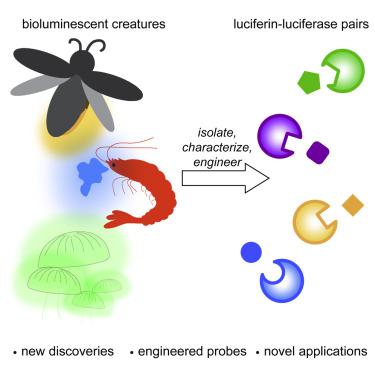Cell Chemical Biology ( IF 8.6 ) Pub Date : 2020-08-13 , DOI: 10.1016/j.chembiol.2020.07.022 Anna C Love 1 , Jennifer A Prescher 2

|
Bioluminescence has long been used to image biological processes in vivo. This technology features luciferase enzymes and luciferin small molecules that produce visible light. Bioluminescent photons can be detected in tissues and live organisms, enabling sensitive and noninvasive readouts on physiological function. Traditional applications have focused on tracking cells and gene expression patterns, but new probes are pushing the frontiers of what can be visualized. The past few years have also seen the merger of bioluminescence with optogenetic platforms. Luciferase–luciferin reactions can drive light-activatable proteins, ultimately triggering signal transduction and other downstream events. This review highlights these and other recent advances in bioluminescence technology, with an emphasis on tool development. We showcase how new luciferins and engineered luciferases are expanding the scope of optical imaging. We also highlight how bioluminescent systems are being leveraged not just for sensing—but also controlling—biological processes.
中文翻译:

看到(和使用)光:生物发光技术的最新发展。
长期以来,生物发光一直被用于对体内生物过程进行成像. 这项技术的特点是荧光素酶和荧光素小分子产生可见光。可以在组织和活生物体中检测到生物发光光子,从而能够对生理功能进行灵敏且无创的读数。传统应用侧重于跟踪细胞和基因表达模式,但新探针正在推动可视化的前沿。过去几年也见证了生物发光与光遗传学平台的融合。荧光素酶-荧光素反应可以驱动光激活蛋白,最终触发信号转导和其他下游事件。本综述重点介绍了生物发光技术的这些和其他最新进展,重点是工具开发。我们展示了新的荧光素和工程荧光素酶如何扩大光学成像的范围。


























 京公网安备 11010802027423号
京公网安备 11010802027423号